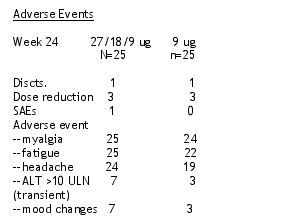 |
 |
 |
| |
High Dose Censensus Interferon in Peg-IFN/Ribavirin Nonresponders
Reported by Jules Levin
|
| |
| |
Report from the Digestive Disease Week Conference, May 17-22, 2003, Orlando, Florida.
Researchers from Germany (Kaiser et al, University Hospital of Tubingen) reported preliminary results from a small study evaluating the efficacy of a Consensus Inteferon (CIFN) induction therapy followed by CIFN/RBV combination treatment in peginterferon/ribavirin nonresponders: "High Viral Response Rates in Previous PEG Interferon/Ribavirin Nonresponder Patients with Hepatitis C Treated with Daily Dosing of Consensus Interferon and Ribavirin", abstract 214.
Patients in the study were randomized open-label to one of two regimens, high dose with an induction & low dose CIFN: (1) CIFN 27 ug once daily for 4 weeks is high dose induction therapy, followed by 12 weeks of CIFN 18 ug once daily with ribavirin 11 mg/kg body weight, followed by CIFN 9 ug once daily with ribavirin 11 mg/kg body weight; or (2) CIFN 9 ug once daily for 4 weeks, followed by CIFN 9 ug once daily plus ribavirin 11 mg/kg body weight. There's a new wrinkle to this study: study patients remain on study treatment for 48 weeks after turning HCV-RNA negative. There's the usual 24-week follow-up period at the end of treatment.
PATIENT CHARACTERISTICS. There are 50 patients in the study, 25 randomized to each dose regimen. 75% male; 47 years old; 95% genotype 1 & 4; 72-80% had HCV viral load >850,000 IU; 24-28% had cirrhosis (Ishak 5 & 6); 64-72% were previously treated with PegIntron/RBV and 28-36% were previously treated with Pegasys/RBV. Body weight for the patients was not reported.
The study authors reported that nonresponse to PEG IFN/RBV therapy was defined as: treatment with at least 1.0-1.5 ug/kg PEG IFN a2b plus ribavirin 1000-1200 mg for 24 weeks or 180 ug PEG IFN a2a plus ribavirin 1000-1200 mg for 24 weeks. Positive HCV RNA PCR at start, week 24, and at least 3 other occasions during therapy (Riche Cobas). Good adherence by patients (ie >80/80/80) as documented by comparison of injections and pills needed and used/prescribed. Patient subgroups defined based on viral decline as null responders (log decline <2) and partial responders (log decline >2).
|
|
 |
| |
The slide showing the graph of the mean viral load reduction displayed a steeper decline in viral load and a sustained higher viral load reduction for the high-dose CIFN regimen patients. Patients were followed to week 24 in this graph and the high-dose CIFN regimen displayed a sustained greater viral load reduction through the 24 weeks and at week 24 than the standard CIFN dose.
Consensus Interferon was biologically designed in a way that the manufacturers tell us it should provide superior response rates. In vitro (in the test tube) CIFN appears to perform in a superior way. They like to call it bio-optimized. We have seen good and promising data using CIFN from several recent studies in Europe and earlier studies, but studies are small, not conclusive and not widely applicable; and here again in this study at DDW we see preliminary interesting data. Week 24 data in nonresponders is not conclusive considering the 50% relapse rate seen by Jacobson in his large study of IFN/RBV nonresponders. The final data from this study will be more telling but the study is small and not performed in US patients giving it limited applicability. The study authors in this CIFN study from DDW did not present the baseline weight of the study patients. Often European patients are lighter in weight than US patients, and this can affect response rates. Patients with lower body weight often have better response rates to therapy.
At the DDW oral presentation of this study, a researcher went to the microphone and raised concern about the tolerability of the side effects and toxicities of CIFN at high doses. Anecdotal reports are that high dose CIFN is difficult to tolerate and may have increased toxicity. Some patients who are nonresponders to PEG IFN/RBV may be able to and willing tolerate more side effects, but larger and better designed studies should be performed to be able to better characterize side effects and toxicities as well as efficacy.
I think the maker of CIFN may be planning larger studies but I'm uncertain. They are planning to develop pegylating CIFN. I think pegylated CIFN studies are expected to begin by the end of 2003.
Here is link to NATAP Reports of ongoing DDW coverage including reports on the results of Jacobson's study of PegIntron/RBV for IFN/RBV nonresponders and discussions regarding options for combination IFN/RBV nonresponders:
http://www.natap.org/2003/DDW/ndxDDW.htm
Safety
There were 3 adverse events reported for patients receiving the standard CIFN regimen and 2 for the high-dose regimen. There was 0 hemotologic toxicity reported for the standard dose regimen and 1 for the high-dose regimen.
Discontinuations of treatment: 1 in each regimen for adverse event and 0 in each arm for hemotologic toxicity.
|
|
 |
| |
AUTHOR CONCLUSIONS
The study authors concluded that CIFN as a high dose and daily dose regimen is safe and moderately tolerable. CIFN 27 ug daily leads to higher early response rates than 9 ug daily. This pilot study provides a proof of concept that PEG-IFN nonresponders may still achieve viral eradication with an intensified therapy of CIFN. CIFN as daily induction therapy at this high dose may result in a promising approach for treatment of PEG IFN nonresponders.
|
|
| |
|
 |
 |
|
|